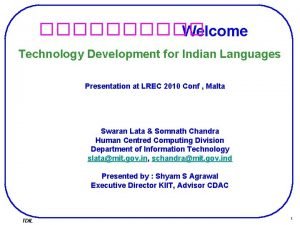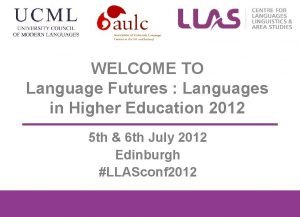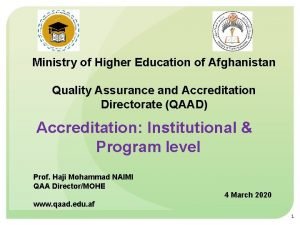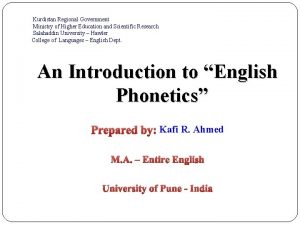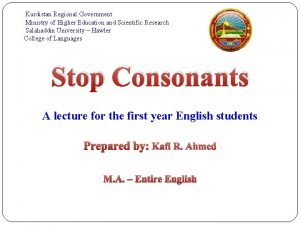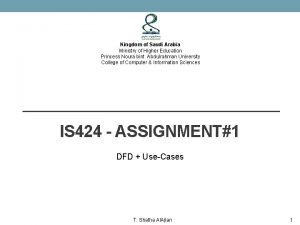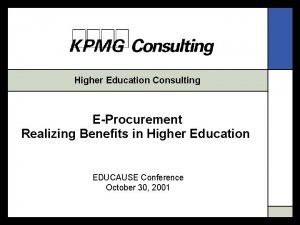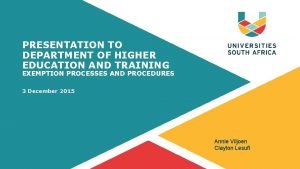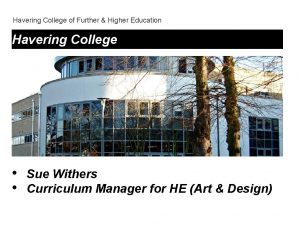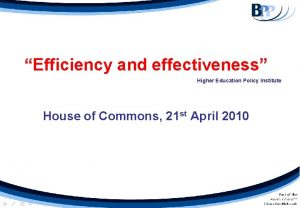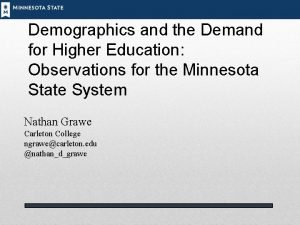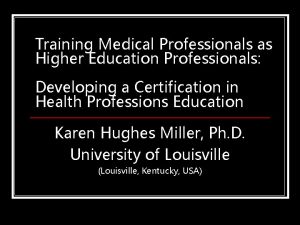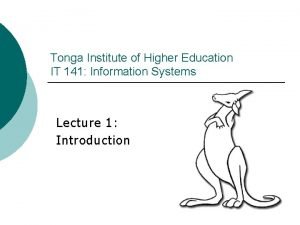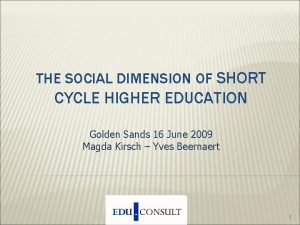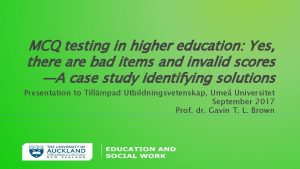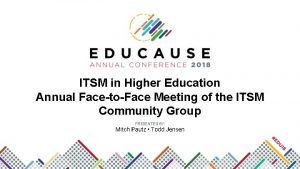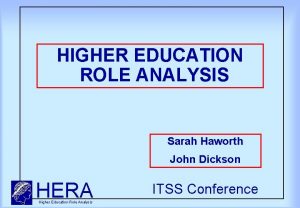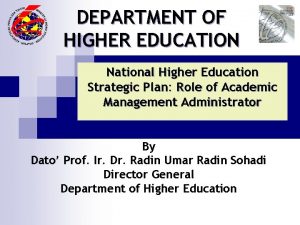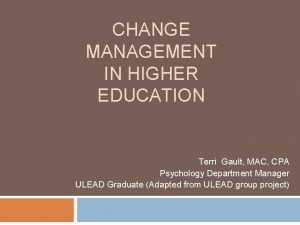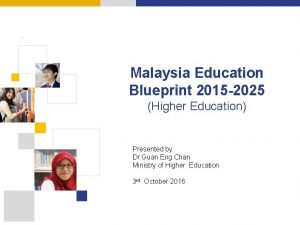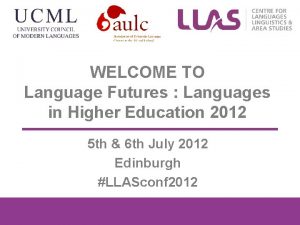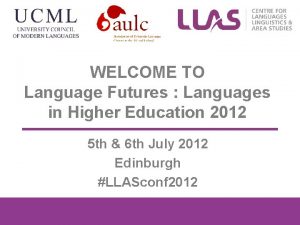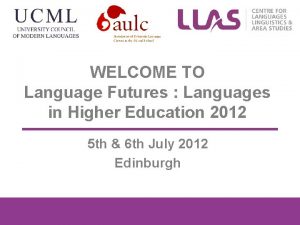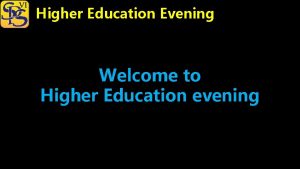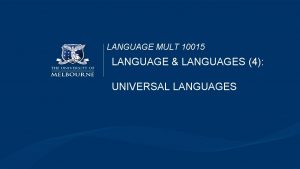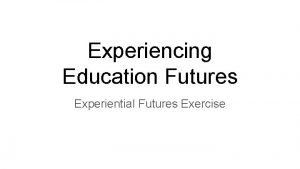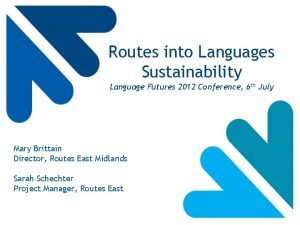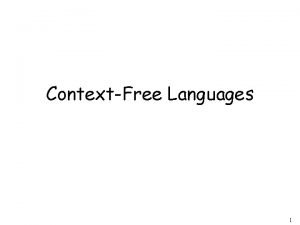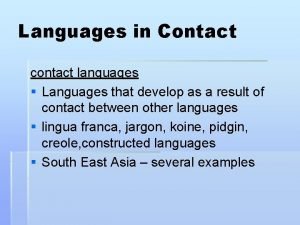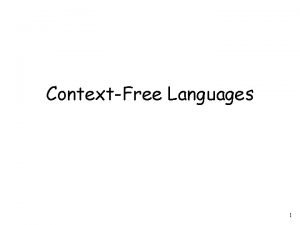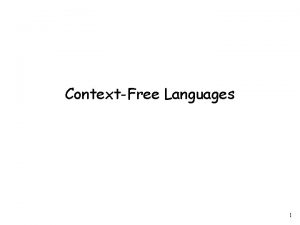WELCOME TO Language Futures Languages in Higher Education













































- Slides: 45

WELCOME TO Language Futures : Languages in Higher Education 2012 5 th & 6 th July 2012 Edinburgh #LLASconf 2012

Evaluating assignment e-feedback in Higher Education María Fernández-Toro, The Open University Elena Polisca, The University of Manchester Languages in Higher Education 2012

The e-Feedback evaluation project Rationale § Assignment feedback is consistently reported by students as an area for improvement § Technology can provide better ways of delivering feedback, but how much does it really help? § The OU provides a good context for evaluating the actual strengths and weaknesses of different modes of e-feedback § The University of Manchester provides a good context for determining to which extent the lessons learnt within the OU are applicable to other educational settings

The e-Feedback evaluation project Aims § To examine the ways in which students and tutors use spoken and written e‑feedback Today Introducing the FACT analysis method § To evaluate the perceptions and preferences of tutors and students in relation to spoken and written e‑feedback Today Preliminary results from OU tutor & student surveys § To investigate the ways in which students engage with the written and spoken e‑feedback that they receive Today Evaluation of peer feedback at University of Manchester

Analysing assignment feedback § Analysis criteria based around two dimensions: – Whether feedback focuses on strengths or weaknesses – How much information the feedback provides, cf ‘depth’ of feedback (Brown & Glover 2006) layers of scaffolding § Analysis tool: Feedback Analysis Chart for Tutors (FACT) Provides a visual ‘profile’ of a tutor’s feedback

Layers of scaffolding in assignment feedback Layer s 1 Comments focusing on weaknesses Error identified only Manos blancos ? ? Error categorised, but not corrected 2 Manos blancos Agreement Error corrected 3 Manos blancos blancas Comments focusing on strengths Strength identified only Good work Strength categorised or described You use a wide range as per marking criteria of language structures Illustrated with specific example from student’s No digo que quieran. . . performance Good use of the subjunctive Explanation given 4 5 Explanation given Although it ends in O, ‘mano’ is a feminine noun. This connector makes it very clear that a new section is starting here. Advice given on how to prevent Revise section 6. 1 errors in future performance Advice given on how to develop Good, you exisiting strengths in future of your grammar book could also look up. . .

Analysing what? Feedback on language assignments at the OU Every year, OU language tutors return. . . § 36, 600 electronic feedback summary forms § 19, 000 annotated word-processed scripts § 18, 000 audio files containing spoken feedback Our sample: § 100 writing assignments § 100 speaking assignments § 4 levels (9 tutors per level) § 108 students (3 per tutor) Feedback consists of: § 200 e-feedback forms § 100 annotated scripts § 100 audio files Tutor Student Well done!

Student and tutor surveys OU students: Beginner Lower Int. Upper Int. Advanced Total Chinese 27 27 French 106 72 23 31 232 German 63 41 16 9 129 Italian 85 46 Spanish 90 80 Welsh 7 Total 378 131 18 22 210 7 239 57 62 OU tutors: N=96 (same modules as above) 736

Survey preliminary results Most important aspect of feedback for the students According to the tutors: Feeling supporte d 27% Gauging own progress 13% Advice for future 14% Feeling supported 8% Getting a good mark 33% Gauging own progress 19% Advice for future 17% Seeing what they got wrong 13% According to the students: Getting a good mark 21% Seeing what they got wrong 35%

Survey preliminary results Medium preferences for giving and receiving feedback § Most useful medium? No preference /Not sure 28% Sound file 15% No preference /Not sure 23% e-form 24% Written script 33% Sound file 9% Tutors’ choices No preference /Not sure 62% Written script 34% § Least useful medium? e-form 14% Written script 5% Sound file 19% e-form 13% No preference /Not sure 60% e-form 34% Written script 5% Sound file 22% Students ’ choices

Attitudes and perceptions: % of agreement with survey statements Student survey Tutor survey 93 97 Feedback on the use of language is useful to students Feedback on the content and structure of assignments is useful to students 87 94 Feedback helps students see what they got wrong 85 Feedback helps students see what they got right 83 Feedback shows students how they can improve Students can remember most of the feedback given to them 72 44 87 84 Feedback does indeed help students learn 82 Feedback makes tudents feel supported 95 87 Feedback helps students understand the marks they get 70 73 Feedback boosts students’ confidence Students normally look forward to seeing their feedback 99 58 38 Tutors should explain every correction they make 97 87 69 Tutors should correct every single error, even minor ones 99 76 41 Students generally make efforts to act upon the feedback Spoken feedback should be given on written assignments too 93 17 27 60 87 97

Attitudes and perceptions: % of disagreement with survey statements Student survey Tutor survey Feedback on the use of language is useful to students 2 1 Feedback on the content and structure of assignments is useful to students 2 Feedback helps students see what they got wrong 0 4 1 Feedback helps students see what they got right 0 3 Feedback shows students how they can improve 6 0 7 Students can remember most of the feedback given to them 3 Students generally make efforts to act upon the feedback 10 5 18 Tutors should correct every single error, even minor ones 11 Tutors should explain every correction they make Feedback does indeed help students learn 1 Feedback makes tudents feel supported 0 Feedback helps students understand the marks they get 1 Feedback boosts students’ confidence 1 38 4 5 3 7 39 Spoken feedback should be given on written assignments too Students normally look forward to seeing their feedback 43 4 3 60

Peer feedback: How do students engage with feedback? In Manchester, students: § Receive paper-based feedback § Receive audio-feedback § Are involved in peer-to-peer feedback – Beginner and finalist groups – Composition / paraphrase work – Students provide corrections on paper – Students provide comments on work (audio or written) + mark – Tutor revises mark and gives further inputs

Peer feedback: How do students engage with feedback? Feedback type: Tutor to Student 1 to Student 3 Morphology + Syntax Italian reads very well, particularly you have used – ING forms (gerunds) very well; Italian is correct but mistakes in spelling and gender of x is feminine. Language is coming on; I am pleased Essay reads well, morph and syntax generally correct. Small mistakes: you use article la; Italians don’t use articles with cities. Two examples of lack of agreements (quotes them) Syntax: here I would say x Lexis + Register Appropriate lexis: high vocab Lexis is excellent (gives examples) Content Good to divide texts in two areas: data + opinion I was expecting more personal engagement! Very clinical! Addressed q. properly. Appropriate structure (short intro, I like conclusion). Very Italian question in intro, well done. Examples used Good percentages and opinions Additional comments Good work, for future mind ‘small’ mistakes I really enjoyed reading your essay

Peer feedback: How do students engage with feedback? Feedback type: Tutor to Student 2 to Student 4 Morphology + Syntax Pleased to see Italian is consistent with last 2 pieces. Language is fluent. Morphology is correct but careful with prepositions and articles Italian reads well. You use subjunctive a lot: good! Use more paragraphs Lexis + Register Several ticks to highlight Used appropriate lexis: words appropriate vocab. Good effort such as x, lots of formal words; in vocab selection x I wasn’t sure about; could have phrased more clearly Content Good job: coherent argument and personal interpretation. Reader is engaged Examples used Good balance between figures Examples are good: real-life and reported opinions examples. Structure good (gives explanation) Additional comments Very pleased; for future mind prepositions. Carry on! Addressed q well, but you answered more the quote than q. ; you talked about x instead of y

What is your favourite way of receiving feedback? (audio / written) 3% Beginners (N=16) 17% 33% 64% 11% 28% SLLC Tutor Audio No Pref Yr 2 Post-beginners (N=17) 15% 68% Yr 2 Post-A level (N=9) SLLC Tutor Audio No Pref Finalists (=16) 12% 16% 22% SLLC Tutor Audio No Pref 39% 72% SLLC Tutor Audio No Pref

Evaluation of peer feedback (audio / written) 4% 2% 14% Has made me more interested in the f/b process Helped me understand how giving f/b works 34% 46% Str agree Agree Neutral Disagree Str disagree 9% 13% 23% Has helped me understand the language of f/b better 19% 24% 12% 13% 32% 37% Str agree Agree Neutral Disagree Str disagree Has made me more aware of the tutor f/b I receive 7% 9% Str Agree Neutral Disagree Str Disagree 18% 22% 15% 47% Str agree Agree Neutral Disagree Str disagree

What happens next? So far… § Student and tutor surveys completed § Sample of tutor feedback collected & anonymised § Peer to peer feedback data collected § Project blog up and running: http: //www. open. ac. uk/blogs/efep/ § Three conferences attended In the next year… § § § § Further analysis of survey results Analysis of feedback collected (FACT profiles, student/tutor rapport, etc. ) Student screencast recordings (‘feedback on feedback’) Evaluation report on different e-feedback modes Guidelines & training materials for tutors and students Online open workshop for HE tutors across the UK Article for peer-reviewed journal New collaborations based on project findings ? ? ?

Project blog: http: //www. open. ac. uk/blogs/efep/ María Fernández-Toro, The Open University Concha Furnborough, The Open University Elena Polisca, The University of Manchester

WELCOME TO Language Futures : Languages in Higher Education 2012 5 th & 6 th July 2012 Edinburgh #LLASconf 2012

What are the Strengths and Weaknesses of the Language Learning Social Networking Site (SNS) www. busuu. com? Centre for languages, linguistics and area studies (LLAS), The University Council of Modern Languages (UCML) and the Association of University Language Centres (AULC). John Mc. Intyre Conference Centre, Edinburgh 5 th and 6 th July 2012 Billy Brick b. brick@coventry. ac. uk Coventry University

Overview Web 2. 0 SNSs: historical context Examples of SNSs and their functionality Research Projects Results Future directions Discussion 22 09/03/2021

SNSs for language learning are: ’disruptive technologies’ in that they allow for new and different ways of doing familiar tasks. Godwin-Jones (2005) 23 09/03/2021

Principles of Tandem Learning (Little 2003) Learner Autonomy • Driving force of Tandem Learning • Hands over control of learning to the learner • First hand contact with a native speaker of the target language Reciprocity • Equal effort and investment = equal benefit • Asynchronous written environment • Synchronous voice environment 24 09/03/2021

25 09/03/2021

Language Learning SNS Functionality Web-based, or increasingly app-based Freemium model Synchronous voice and synchronous and asynchronous text chat and e-mails Contain picture-based learning materials Peer review of written and spoken submissions Profile matching (languages, levels) Motivational tools (berries, league tables, corrector badges) 26 09/03/2021

1 Individual learning 2 Community learning Marcel + Content based on 150+ different topics (e. g. telling the time, answering the phone, etc. . ) Grammar material provided by PONS and Collins Supported by photos and voices of professional voice artists Language material available in Spanish, German, French, English, Italian, Russian, Turkish, Polish, Portuguese, Arabic, Japanese and Mandarin busuu. com © 2011 27 teach Susanne teach native medium beginner native beginner Instant video-chat application for direct conversation between users Peer-to-peer correction of writing and speaking exercises by the community Currently around 100, 000 unique user visits per day and more than 25, 000 text corrections per day.

busuu. com is Europe’s largest language learning community with more than 2. 5+ million users Growth of community Awards & recognition Always. On Global 250 Winner Today there are more than More than 2, 500, 000 1, 600, 000 users registered users European Union innovation award in language learning Ce. BIT Innovation Award Shortlist best European Website Winner Open Talent Competition May 08 busuu. com © 2011 Jan 09 May 09 Jan 10 May 10 28 Mar 11 Red Herring European Winner 2010

Freemium Model Premium Vocabulary in English, Spanish, French, German, Italian, Russian, Portuguese Writing exercises Reading comprehension exercises Video Chat Application for live-talk Interactive exams Audio for more than 3, 000 key phrases Listening comprehension exercises Printable PDFs for more than 150 units Access to more than 35 Grammar Units Audio Podcasts for more than 150 units Live Video Units Customized Review Travel Courses Voice Recording Feature + more. . . + Access to detailed Grammar guides! busuu. com © 2011 30 Free

busuu. com © 2011 31

The Research q 12 level 3 learners spent 3 months learning German on the site – questionnaires, log sheets and classroom observations. Mostly British aged 21. q. Similar experiment 12 months later. q. LLAS e-Symposium Practitioners Workshop - 13 practitioners took part in a 3 hr workshop and discussion – questionnaires. Mixed European nationalities aged 25 -60. 32 09/03/2021

Please suggest any ways in which you think the www. busuu. com university platform could be improved. “More natural pronunciation and dialogues reflecting current and authentic use of language. Dialogues were stilted and overarticulated, often with the same voice playing 2 Please suggest any ways in which you think parts which makes it hard to follow. It was hard the www. busuu. com university platform to work out how to get into things - unintuitive could be improved. interface. The tour wasn't enough to figure out the navigation. ” 44 09/03/2021

“Exercises and activities for levels higher than B 2. ” “It is not challenging enough for students of A level quality. " 45 09/03/2021

“In comparing busuu to livemocha, busuu is less structured and it is hard to know 'where to go next' sometimes in busuu. The site navigation seems a bit chaotic. ” 46 09/03/2021

Name three things you liked “Access to a real community of learners live chat peer learning. ” “Garden metaphor, the berries and the visual design. ” “Games, chat, reviews” “I wrote a message to an online student and he responded very quickly. The length of a lesson is good. I like the frequent tests. ” “Instant feedback. Self-correcting exercises, social networking. ” 47 09/03/2021

Name three things you didn’t like “The lesson tooltip hardly ever gives an indication of the grammar covered. The tests are too predictable, too easy. It would be good to have levels C 1 and C 2 as well. ” “Danger for incorrect feedback. Too open for possible frauds. ” “The level was far too basic. My sentences got corrected very quickly (good!) but some of the corrections were wrong - there is no quality control. ” “No way to guarantee that feedback received is accurate and reliable Speakers' accents on listening tasks sound artificial. ” 48 09/03/2021

49 09/03/2021

Strengths • Basic features free of charge • Immediate peer review and chat with native speakers • Flexibility (anytime, anywhere) • Fun and motivating • Autonomous learning 50 09/03/2021

Weaknesses • Lack of expertise from peer feedback • Need to pay for premium content (and higher levels) • Learning materials could be improved (behaviouristic) • Unsolicited advances and inappropriate advertising 51 09/03/2021

busuu. com © 2011 52

busuu. com © 2011 53

54 09/03/2021

References boyd d m, & Ellison N B (2007), ‘Social networks: Definition, history, and scholarship’, Journal of Computer-Mediated Communication, vol. 13, no. 1, [online] available from http: //jcmc. indiana. edu/vol 13/issue 1/boyd. ellison. html [23 rd May 2011] Brick, B. (2011) How effective are web 2. 0 language learning sites in facilitating language learning? Compass: The Journal of Learning and Teaching at the University of Greenwich. Issue 3, 57 -63 Brick, B. (2011) Social Networking Sites and Language Learning. International Journal of Virtual and Personal Learning Environments. 2 (3) 18 -31 (Copyright 2010, IGI Global, www. igiglobal. com. Posted by permission of the publisher. ) [31 st August 2011] Brick, B, (forthcoming 2012) The Role of Social Networking Sites for Language Learning in UK Higher Education: the Views of Learners and Practitioners International Journal of Computer. Assisted Language Learning and Teaching Godwin-Jones, B (2005) Emerging technologies: Skype and Podcasting. Disruptive technologies for language learning. Language Learning & Technology, 9(3), 9 -12. Guo, S (2010) From printing to Internet, are we advancing in technological application to language learning? British Journal of Educational Technology Vol 41 No 2 E 10 -E 16. Harrison, R. & Thomas, M. (2009) Identity in Online Communities: Social Networking Sites and Language Learning. International Journal of Emerging Technologies & Society Vol. 7, No. 2, 2009, pp: 109 – 124. [Online] available from <http: //www. swinburne. edu. au/hosting/ijets/journal/V 7 N 2/pdf/Article 4 -Harrison. Thomas. pdf> [23 rd May 2011] 55 09/03/2021

Hurd, S (1998) “Too carefully led or too carelessly left alone”? Language Learning Journal, No 17, 70 -74 Little, D. (2003) Tandem Language Learning and Learning Autonomy. In Lewis, T. and Walker, L. (eds. ), Autonomous language learning in tandem. Sheffield: Academy Electronic Publications Mc. Bride, K (2009) Social-Networking Sites in Foreign Language Classrooms In Lomicka, L. , & Lord, G. (Eds. ) The next generation: Social networking and online collaboration in foreign language learning. San Marcos, TX: CALICO Book Series Mullen, T. , Appel, C & Shanklin, T. (2009). Skypebased tandem language learning and web 2. 0. In M. Thomas (Ed. ), Handbook of research on Web 2. 0 and second language learning (pp. 101– 118). Hershey, PA: Igi Global. 56 09/03/2021

WELCOME TO Language Futures : Languages in Higher Education 2012 5 th & 6 th July 2012 Edinburgh #LLASconf 2012
 Welcome in indian languages
Welcome in indian languages Language futures
Language futures Welcome welcome this is our christmas story
Welcome welcome this is our christmas story Web analytics in higher education
Web analytics in higher education Capacity building in the field of higher education
Capacity building in the field of higher education Importance of faculty in higher education
Importance of faculty in higher education Rhode island board of governors for higher education
Rhode island board of governors for higher education Higher education ppc
Higher education ppc Ministry of higher education (afghanistan)
Ministry of higher education (afghanistan) Massachusetts higher education consortium
Massachusetts higher education consortium Ministry of education kurdistan
Ministry of education kurdistan Kurdistan
Kurdistan Kurdistan higher education
Kurdistan higher education Ministry of higher education saudi arabia
Ministry of higher education saudi arabia Internationalization of higher education in the philippines
Internationalization of higher education in the philippines Higher education eprocurement
Higher education eprocurement Digital initiatives in higher education
Digital initiatives in higher education Gartner digital transformation in higher education
Gartner digital transformation in higher education Development of higher education in india
Development of higher education in india Learning without burden
Learning without burden Collaborative on academic careers in higher education
Collaborative on academic careers in higher education Texas women in higher education
Texas women in higher education Department of higher education and training
Department of higher education and training Mitochondria
Mitochondria Higher education achievement report
Higher education achievement report Business intelligence in higher education
Business intelligence in higher education Higher education access tracker
Higher education access tracker Havering college of further and higher education
Havering college of further and higher education Efficiency and effectiveness in higher education
Efficiency and effectiveness in higher education Demographics and the demand for higher education
Demographics and the demand for higher education Higher education mauritius
Higher education mauritius Training for higher education professionals
Training for higher education professionals Tonga institute of higher education
Tonga institute of higher education Short cycle higher education
Short cycle higher education Ohio department of higher education
Ohio department of higher education Hp higher education
Hp higher education Simply misplaced
Simply misplaced Mcq on higher education
Mcq on higher education Itsm for higher education
Itsm for higher education Higher education role analysis
Higher education role analysis Four segments of higher education
Four segments of higher education Uvu professor salary
Uvu professor salary National higher education strategic plan
National higher education strategic plan Change management in higher education
Change management in higher education Unit 5 higher education
Unit 5 higher education Malaysia education blueprint 2015 to 2025
Malaysia education blueprint 2015 to 2025
